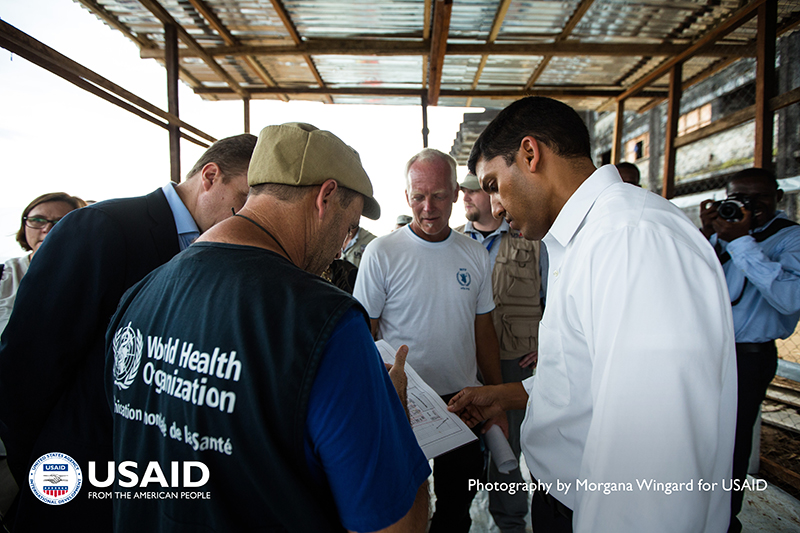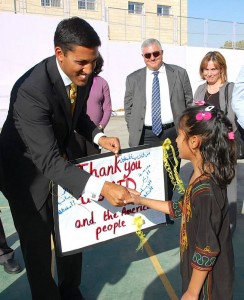
When the U.S. Agency for International Development celebrated its 50th anniversary in 2011, Raj Shah told me and others at the agency, in so many words, that we should make sure USAID doesn’t live to see 100.
As USAID’s Chief of Staff and then its Chief Operating Officer for the first half of Shah’s tenure, I knew Shah did not in any way want to kill the world’s largest, most important development assistance donor. Quite the opposite in the short-term.
He felt, rightly, though, that if we’re still doing assistance the same way 50 years in, then we haven’t done enough. If we change, accelerate and scale the way we do things, then we shouldn’t be around—at least not in the same form—to “celebrate” 100 years of providing aid.
Shah reminded all of us that development assistance should be around only for so long.
At 50 years, there was a lot for USAID to celebrate. During the anniversary celebration, he and Vice President Joe Biden spoke of the agency’s legacy of developing and scaling innovative breakthroughs—from the seeds of the green revolution, to microfinance and oral rehydration therapy—that saved lives, created opportunity and advanced human development.
As USAID Administrator for the past five years, Shah brought more life to the agency than it has seen arguably since its beginnings during the Vietnam War. That is certainly the view from the White House, Capitol Hill and Foggy Bottom.
Shah has led a series of development assistance reforms, under the heading of USAID Forward, and created the Global Development Lab. In conjunction with a smart, committed team of agency veterans, dedicated development experts and civil servants, new Development Leadership Initiative officers, and political appointees, Shah focused on beefing up the agency, its staff and expertise; on strategic partnerships and local solutions; on science, technology and innovation; and on evidence, learning and scaling.
Those efforts, and, more important, whether they stick, will be his legacy.
The need to inspire and “manage the building”
 Within seconds of meeting Raj for the first time, one sees his energy, commitment, charm, quickness, smarts and ambitions. He is inspiring. If his negatives are fewer and harder to figure, he points them out to you.
Within seconds of meeting Raj for the first time, one sees his energy, commitment, charm, quickness, smarts and ambitions. He is inspiring. If his negatives are fewer and harder to figure, he points them out to you.
He doesn’t point out his own weaknesses simply as an excuse, though. He is capable and ambitious enough to want to address them.
With senior staff, Shah established and dedicated time to an Administrator’s Leadership Council that aimed to solve management problems and provide greater support to and engagement with Agency staff at all levels.
The best leaders know that the most effective way forward is to bring everyone forward together, asking others to lead the way as well.
When we left USAID, separately at our going-away parties, another senior political appointee and I both quoted Maya Angelou: “I’ve learned that people will forget what you said, people will forget what you did, but people will never forget how you made them feel.”
Including all the “smartest” players to end poverty

Shah often cited James Wolfensohn as saying when he was World Bank President: “We’re not the smartest in the room anymore. The smartest in the room is the room.”
Shah, along with many others in development, fully realizes and works to leverage the fact that government-funded aid agencies are not the only big or important players in development. Washington, London and Paris are not the only key centers generating funding, leadership and innovation.
Wealthy individuals and their foundations put billions of dollars, pesos, pounds, rands and rupees into international development assistance.
Corporate foundations and even business arms are becoming much bigger players too in terms of their active involvement and funding. These are not just large multinational corporations based in the U.S. or Europe but also national and regional companies born in the developing world that are now making not just a name and a profit, but also a difference, in development.
The most important change may be connection to and leveraging of the ideas, innovations and solutions coming from a broader, deeper swath of people and organizations globally and at every level. People who have long held knowledge of their own development needs and solution but have never had the opportunity to develop, market and implement their ideas are now playing a larger role in developing their families, communities, countries and world.
Shah says, “Our agency must serve as a platform that connects the world’s biggest development challenges to development problem solvers all around the world. We recognize that talent is everywhere, but opportunity is not.”
President Barack Obama, who issued the first ever Presidential Directive on Development, said in his 2013 State of the Union address that the U.S. will join its allies to eradicate extreme poverty in the next two decades by “connecting more people to the global economy; by empowering women; by giving our young and brightest minds new opportunities to serve, and helping communities to feed, and power, and educate themselves….”
The new Sustainable Development Goals, being drafted now to follow the Millennium Development Goals that end this year, put a big focus on inclusion to end poverty. This means not only inclusion among those being brought out of poverty, but also inclusion and partnership among those seeking, building and implementing solutions.
A poverty-ending legacy?

As Raj Shah prepares to leave USAID and the Obama Administration next month, the focus will be on his legacy as USAID Administrator.
Raj Shah will be known as the Administrator who was energetic, smart, dedicated and ambitious, and who recognized, inspired and leveraged the people, leadership and ideas inside and beyond USAID necessary for a committed and permanent focus on the partnerships, innovation and scale that will eventually put US donor assistance (and all international donors) out of business because poverty-ending solutions will be successful and sustained locally?
A veteran Foreign Service officer who is still at USAID told me this about her recent posting in USAID’s New Delhi Mission. Realizing that there are 170,000 millionaires and 117 billionaires in India, she wanted to get some of them involved as partners in development efforts nationally and further afield. (Shah has promoted and partnered with India on a triangular partnership to bring Indian innovation and leadership to Africa.) Indian colleagues at the Mission told her the rich only give to Hindu temples.
In line with Shah, she persisted in her idea to ask them to give to development—to help pay to scale up some of the amazing, Indian-born poverty-reduction solutions.
Highly loved and lauded Agency Counselor Dave Eckerson wrote this in a blog just before retiring: “The spirit of USAID Forward is in the hearts and minds of everyone in the Agency. For me, the reforms are in the rearview mirror, and they are leading us to the lane ahead. They are our new reality…and as we take up the president’s call to end extreme poverty in a generation, they will be on the horizon as well.”
I believe that a focus on “we-cannot-do-this-alone” strategic partnerships, and real scaling of development innovations, local solutions and evidence-based results—will significantly diminish or even eradicate several of the world’s toughest, clearest poverty indicators. This will be Raj Shah’s legacy.
Only time will tell. Hopefully, it will not take 50 more years.
Sean C. Carroll is Senior Director at Creative Associates International.